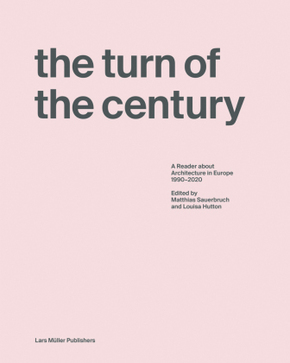
The Turn of the Century - A Reader about Architecture in Europe 1990-2020
| Verlag | Lars Müller Publishers |
| Auflage | 2021 |
| Seiten | 164 |
| Format | 24,8 x 1,7 x 30,4 cm |
| Gewicht | 798 g |
| Artikeltyp | Englisches Buch |
| ISBN-10 | 3037786744 |
| EAN | 9783037786741 |
| Bestell-Nr | 03778674A |
Following the pair of monographic "Sauerbruch Hutton Archives" (Archive, 2006; Archive 2, 2016) Lars Müller Publishers presents a reader edited by the architects. Matthias Sauerbruch and Louisa Hutton have asked a diverse group of authors to reflect on the various conditions that have shaped the conception, production and dissemination of architecture in Europe over the course of the last three decades, and of the architecture that has resulted. The essays generally include observations on one or more of Sauerbruch Hutton's buildings, but these do not necessarily form the focus of the respective texts.The authors include critics who have written on the work of the practice in the past, architectural colleagues and writers whose opinions and observations are respected by the editors as well as a handful of people who either live or work in one of their buildings and so have experienced Sauerbruch Hutton's architecture firsthand. Further, a photographic essay by the Finnish artistOl a Kolehmainen will augment the twenty-five essays with works created between 1990 and 2020. Analogous to the written pieces, these are images in their own right and of their own subjects that have been triggered by the presence of one of Sauerbruch Hutton's buildings.von denen viele bereits vor der zweiten Ausstellung 1964 starben.Sverre Fehn, Nordic Pavilion, Venice porträtiert zudem die Vielzahl der am Bau beteiligten Personen, die von Königen, Premierministern, Bürokraten, Botschaftern, Museumsdirektoren, Architekten und diversen Künstlervereinigungen bis hin zu venezianischen Würdenträgern, Ingenieuren, Gärtnern, Anwälten und Klempnern reicht. Der Pavillon wurde vor dem Hintergrund von Freundschaften und Animositäten, Machtspiel und Diplomatie konzipiert und gebaut. Die Umwege und Enttäuschungen, Erfolge und Misserfolge der Venedig-Affäre bilden ein Prisma, welches die Denkweise und die widersprüchlichen Ambitionen der nordischen Länder in den 1950er- und 60er-Jahren verstehen lässt. Grosszügig illustriert mit bisher unveröffentlichten Bildern, darunter viele von Fehn gemachte Aufnahmen, werfen die Archivdokumente auch ein neues Licht auf einen der grossen nordischen Architekten der jüngsten Vergangenheit.
